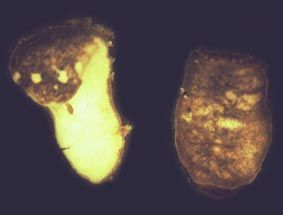Major Group: Platyhelminthes
SubOrder: Tricladida
Family: Dugesiidae
Aquatic species in Australia belong to a single family, Dugesiidae. |
Descriptive Features: typically dark grey to brownish, also tending to white, some species are colourless but may contain red or green internal material
bilaterally symmetrical, elongate, flattened soft body, or sub cylindrical
distinct head
2 or more eyespots may be present anteriorly, or eyespots absent
2 lateral triangular extensions may be present at anterior end
Total length: 5 mm - 30 mm
|

|
Dugesia glandulosa |
|
|

|
Dugesia glandulosa |
|
Taxonomic Checklist: Genera
Bdellasimlis barwicki Richardson
Cura pinguis Weiss
Dugesia
Eviella hynesae Ball
Spathula
Romankenkius
Reynoldsonia reynoldsoni Ball
Weissius capaciductus Sluys, 2007 |
|
Distribution: all states
Sensitivity Rating: SIGNAL grade 2
Functional Feeding Group: predators |

|
Molonglo River, Coppins Crossing ACT |
|
|
Ecology: Instream habitat: Dugesiidae species occur in streams and shallow regions of freshwater lakes. They are found on the undersides of submerged rocks and wood. Dugesiid flat worms can withstand moderate salinities and survive in temporary waters. Most species are free living although some species may be ectocommensal on crayfish. The host crustacean is not harmed by the flat worm.
Feeding ecology: Dugesiid flat worms are more omnivorous than carnivorous. They typically feed on live or decaying animal matter and larger individuals can consume larger active invertebrates.
Habit: Large dugesiid individuals canít swim, instead they move by gliding on their ventral surface over the substratum and submerged objects or underside of the water surface film. Gliding is typically actioned by the cilia moving upon a layer of mucus secreted by special ventral glands, however the larger individuals can also move by muscular waves along the ventral surface. Smaller individual can swim, using the cilia, as well as glide. All Dugesiidae species stay out of the light.
Life history: Dugesiidae species are hermaphrodites and reproduce sexually by cross fertilization. Several species are capable of asexual reproduction by a process of transverse fission. Eggs are deposited singly or in groups within a tough leathery cocoon, both types are attached to substratum by a short stalk. Dugesiid flat worms have resting eggs to survive unfavourable conditions. The young hatch as miniature forms of the adults. Adults are able to regenerate; if an individual is cut in two then two separate individuals may form. |
| |
Information Sources: Sluys et al. 2007, Williams 1980, Hay & Ball 1979, Ball 1979, Ball 1974, Richardson 1968, Hawking & Smith 1997, Gooderham & Tsyrlin 2002
Key to Genera: Ball 1979 (Tas)
Key to Species: Ball 1979 (Tas) |
|
|
|